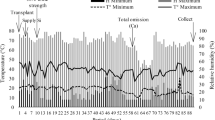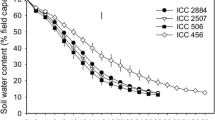Abstract
The cowpea (Vigna unguiculata (L.) Walp.) cultivars TVu 354 and Solojo were grown in solution culture at 10 to 1000 μM Ca supply. The Ca supply did not vary by more than 10% during the experiment. The pH value was kept constant within 0.1 units at 4.0 by automatic titration. The cultivar TVu 354 proved to be much more Ca-efficient than Solojo. At 10 μM Ca supply Solojo died, whereas TVu 354 was hardly affected in dry matter production. The differences in Ca efficiency were independent of the P supply. They could not be explained by differences in Ca uptake or Ca concentrations in the plant tissue. Short-term studies using 45Ca, both in the dark and in the light, indicated better transport of Ca from the roots to the shoots and within the shoots to the younger leaves in the Ca-efficient cultivar TVu 354. However, the main reason for the differences between the cultivars in sensitivity to low Ca supply were differences in the Ca requirement of the plant tissue to maintain tissue organization and function. Sequential fractionation of the freeze-dried leaf tissue with hot water, 0.5 M NaCl, 1 M CH3COOH, and 2 M HCl did not reveal cultivar differences in Ca binding state. The results clearly show that considerable genetic potential in tolerance to low Ca supply exists in cowpea. However, a better understanding of the physiological/biochemical reasons for low internal Ca requirement is needed.
Similar content being viewed by others
References
Bangerth F 1979 Calcium-related physiological disorders of plants. Annu. Rev. Phytopathol. 17, 97–122.
Banuelos G S, Bangerth F and Marschner H 1987 Relationship between polar basipetal auxin transport and acropetal Ca2+ transport into tomato fruits. Physiol. Plant. 71, 321–327.
Banuelos G S, Bangerth F and Marschner H 1988 Basipetal auxin transport in lettuce and its possible involvement in acropetal calcium transport and incidence of tipburn. J. Plant Nutr. 11, 525–533.
Behling J P, Gabelman W H and Gerloff G C 1989 The distribution and utilization of calcium by two tomato (Lycopersicon esculentum Mill.) lines differing in calcium efficiency when grown under low-Ca stress. Plant and Soil 113, 189–196.
Bruce R C, Warrell L A, Edwards D G and Bell L C 1988 Effects of aluminium and calcium in the soil solution of acid soils on root elongation of Glycine max c. Forrest. Aust. J. Agric. Res. 38, 319–338.
Brumagen D M and Hiatt A J 1966 The relationship of oxalic acid to the translocation and utilization of calcium in Nicotiana tabacum. Plant and Soil 24, 239–249.
Camargo C E O, Kronstad W E and Metzger R J 1980 Parent-progeny regression estimates and associations of height level with aluminium toxicity and grain yield in wheat. Crop Sci. 20, 355–358.
Cox E F 1980 Growth of lettuce roots and its possible relationship to tipburn development. Hortic. Res. 20, 61–66.
English J E and Maynard D N 1981 Calcium efficiency among tomato strains. J. Am. Soc. Hortic. Sci. 106, 552–557.
English J E and Barker A V 1982 Water-soluble calcium in Ca-efficient and Ca-inefficient tomato strains. Hortic. Sci. 17, 929–931.
Ferguson J B, Turner N A and Bollard E G 1980 Problems in fractionating calcium in plant tissue. J. Sci. Food Agric. 31, 7–14.
Giordano L B, Gabelman W H and Gerloff G C 1982 Inheritance of differences in calcium utilization by tomatoes under low-calcium stress. J. Am. Soc. Hortic. Sci. 107, 664–669.
Godbold D L, Fritz E and Hüttermann A 1988 Aluminium toxicity and forest decline. Proc. Natl. Acad. Sci. USA 85, 3888–3892.
Guttridge C G, Bradfield E G and Holder R 1981 Dependence of calcium transport into strawberry leaves on positive pressure in the xylem. Ann. Bot. 48, 473–480.
Häussling M, Jorns C A, Lehmbecker G, Hecht-Buchholz Ch and Marschner H 1988 Ion and water uptake in relation to root development in Norway spruce (Picea abies (L.) Karst). J. Plant Physiol. 133, 486–491.
Haynes R J 1980 Ion exchange properties of roots and ionic interactions within the root apoplasm: Their role in ion accumulation by plants. Bot. Rev. 46, 75–99.
Hochmuth G J 1984 Variation in calcium efficiency among strains of cauliflower. J. Am. Soc. Hortic. Sci. 109, 667–672.
Horst W J 1987 Aluminium tolerance and calcium efficiency of cowpea genotypes. J. Plant Nutr. 10, 1121–1129.
Horst W J and Klotz F 1990 Screening soybean for aluminium tolerance and adaptation to acid soils. In Genetic Aspects of Plant Mineral Nutrition. Eds. N El Bassam, M Dambroth and B C Loughman. pp 355–360. Kluwer Academic Publishers, Dordrecht, The Netherlands.
Islam A K M S, Asher C J and Edwards D G 1987 Response of plants to calcium concentration in flowing solution culture with chloride or sulphate as the counter-ion. Plant and Soil 98, 377–395.
Kennedy C W, Smith W C and Ba M T 1986 Root cation exchange capacity of cotton cultivars in relation to aluminium toxicity. J. Plant Nutr. 9, 1123–1133.
Kinzel H 1983 Influence of limestone, silicates and soil pH on vegetation. In Physiological Plant Ecology III Encyclopedia of Plant Physiology; New Series Vol 12C. Eds. O L Lange, P S Nobel, C B Osmond and H Ziegler. pp 201–244. Springer-Verlag, Berlin.
Klotz F and Horst W J 1988 Effect of ammonium- and nitrate-nitrogen nutrition on aluminium tolerance of soybean (Glycine max L.). Plant and Soil 111, 59–65.
Loneragan J F and Snowball K 1969 Calcium requirements of plants. Aust. J. Agric. Res. 20, 465–478.
Marschner H and Cakmak I 1986 Mechanism of phosphorus-induced zinc deficiency in cotton. II. Evidence for impaired shoot control of phosphorus uptake and translocation under zinc deficiency. Physiol. Plant. 68, 491–496.
Sapra V T, Mebrahtu T and Mugwira L M 1982 Soybean germplasm and cultivar aluminium tolerance in nutrient solution and Bladen clay loam soil. Agron. J. 74, 687–690.
Schilling G 1960 Strontium in der höheren Pflanze. II. Verteilung und Bindungszustand in der Pflanze. Z. Pflanzenernaehr. Bodenkd. 91, 212–224.
Tukey J W 1949 Comparing individual means in the analysis of variance. Biometrics 5, 99–114.
Author information
Authors and Affiliations
Rights and permissions
About this article
Cite this article
Horst, W.J., Currle, C. & Wissemeier, A.H. Differences in calcium efficiency between cowpea (Vigna unguiculata (L.) Walp.) cultivars. Plant Soil 146, 45–54 (1992). https://doi.org/10.1007/BF00011994
Issue Date:
DOI: https://doi.org/10.1007/BF00011994




